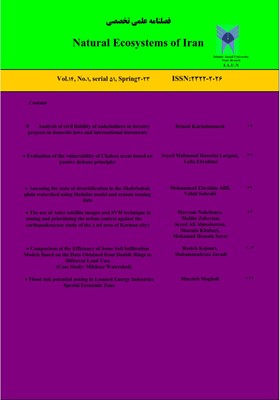سنجش آسیبپذیری شهرها براساس اصول پدافند غیرعامل با استفاده از روش سلسله مراتبی فازی(نمونه موردی: شهر چالوس)
الموضوعات :
سید محمود حسینی لرگانی
1
,
لیلا ابراهیمی جمنانی
2
1 - گروه جغرافیا، واحد چالوس، دانشگاه آزاد اسلامی، چالوس، ایران
2 - گروه جغرافیا، واحد چالوس، دانشگاه آزاد اسلامی، چالوس، ایران.
تاريخ الإرسال : 26 الخميس , جمادى الثانية, 1444
تاريخ التأكيد : 11 الأربعاء , ذو القعدة, 1444
تاريخ الإصدار : 03 الأربعاء , ذو الحجة, 1444
الکلمات المفتاحية:
چالوس,
آسیبپذیری,
پدافندغیرعامل,
سلسله مراتب فازی,
ملخص المقالة :
ارزیابی آسیبپذیری شهرها در بحرانها و مخاطرات و تدوین راهکارهای مناسب برای کاهش خسارتها ضروری است. از این رو این پژوهش در پی آن است که آسیبپذیری شهر چالوس را از دیدگاه پدافند غیرعامل ارزیابی کند. این پژوهش از لحاظ هدف، کاربردی؛ حیطه میدانـی؛ مـاهـیـت، توصیفی و نوع روش آن، بهصورت پیمایشی از نـوع دلـفـی اسـت.. ابتدا به کمک مطالعات کتـابـخـانـهای و میدانی و تصاویر ماهوارهای به جمعآوری اطلاعات در زمینه موضوع تحقیق پرداخته شد،پس از بررسی کاربریها در سطح شهر چالوس و دستهبندی آنها در قالب 5 دسته شامل شریانهای حیاتی، مراکز مدیریت بحران، تأسیسات و تجهیزات شهری، نظامی، و مراکز پشتیبانی و با توجه به مبانی نظری و متون تحقیق و پرسش از خبرگان این حوزه، کاربریها به صورت موردی استخراج و با هدف تهیه بانک دادههای مکانی دستهبندی شدند. هر یک از لایهها با توجه به استاندارد مکانی همجواری و به نسبت فاصلهشان با کاربریهای حیاتی و حساس از نظر پدافند غیرعامل اثر متفاوتی را بر افزایش یا کاهش آسیبپذیری میگذارند. برای هر لایه به نسبت کاربریهای حیاتی و حساس از نظر پدافند غیرعامل، حریم امنی تعریف و به اصطلاح، نقشههای فواصل مکانی آن ترسیم شده است. در نهایت نقشهپهنهبندی آسیبپذیری منطقه با توجه به اصول پدافند غیرعامل تهیه گردید. براساس شکل به دست آمده، شهر چالوس به سه پهنه که از لحاظ آسیبپذیری با رویکرد پدافند غیرعامل مشابهند، تقسیم شده است. نتایج تحقیق نشان میدهد، محلات مرکزی شهری آسیبپذیرترین مناطق شهرند.
المصادر:
Akhwan Abdullahian, Mohammad Reza, Taqvai, Masoud, Warsi, Hamid Reza, 2016, determining the type of and their physical-spatial location selection criteria with an emphasis on unnatural crises (inoperative defense) using AHP method (case example of Sabzevar city), Research Quarterly Geography, 32(1): 43-58
Amanpour, Saeed, Mohammadideh Cheshme, Mohammad, Parvizian, Ali, 2017, evaluation of passive defense requirements in the vicinity of case studies: Ahvaz metropolis, Journal of Geography and Urban-Regional Planning, 26(3): 217-224.
Allahyari, Amir, Tavakalinia, Jamlieh, Mehrabi, Ali, 2017, City Vulnerability Assessment with Passive Defense Approach (Case Study: District 20 of Tehran City), Capital Police Police Knowledge Quarterly, 11(36): 63-97
Bastani, Mojdeh, Mohammadniai Qaraei, Fatemeh, Saeedi Mofard, Sanaz, 2018, Evaluation of the urban context based on the principles of passive defense using FANP factor network analysis process method, case study: Noghan neighborhood of Mashhad, Geographical Research Quarterly, 34(1) , 87-105
Bakhshi Shadmehri Fatemeh, Dr. Seyed Hadi Zarkani, Dr. Omid Ali Kharazmi, (2015), Analysis of passive defense considerations in urban infrastructure with emphasis on water infrastructure, Geographical Research Quarterly, 31(35): 26-41.
Cuhls, k., 2007, Methods to Elicit Forecasts from Groups: Delphi and Prediction Markets Compared [online]. Munich Personal Repec Archive, http://mpra.ub.uni-muenchen.de
Fischer, H.; Scharnberger, K.; Geiger, C. 1996. Reducing seismic vulnerability in low to moderate risk areas. Disaster prevention and management, 5(4), MCB University
Gholami, Mohammad, Nazari, Vahid, Nasiri, Arzo, Horizad, Ali, 2014, Analysis of administrative-service centers of gravity of the city based on the principles of passive defense (case study: Buin Zahra city), Urban Planning Studies Quarterly, 2(6), 55-77 .
Kamran, Hamed, Amini, Dawood, Hosseini-Amini, 2013, Application of passive defense in urban housing planning, Journal of Urban and Regional Studies and Research, 4(15), 75-93.
Habibi, Kamran, (2017), Determining effective construction factors in the vulnerability of the ancient urban fabric of Zanjan using GIS and Fuzzy Logic, Fine Arts Journal, 12(33): 36-27.
Hartman, T. ,2007, The Delphi Method for Graduate Research, Journal of Information Technology Education, 12(6): 1022-1039.
Hashemi Shaharaki, Javad; Patience, Amir. 1390, urban design from the perspective of non-active defense," Tehran, Bostan Hamid Publications
Hosseini, SB. The develop criteria of passive defense in Public architecture. Training and Research Institute of passive defense. School of Architecture and Urban Tehran University. Tehran. 2008.
Linston, Harold A., and Murray Turoff. 1975. Introduction to the Delphi Method: Techniques and Applications. London: Addison-Wesley.
Maimandi Parisi, S., Kazminia, A., 2014, Vulnerability zoning of Kerman city based on the principles of non-active defense, Amash Sarmeen magazine, 7th period, 1st issue, spring and summer. pp. 119-144.
Rinaldi, Steven M., James P. Peerenboom, and Terrence K. Kelly, 2001. Identifying, understanding, and analyzing critical infrastructure interdependencies, IEEE Control Systems,21(6):11-25
Rahmani Fazli Ali, Saidi Rad, Mohammad, Amini, Saeed, 2015, Security evaluation of rural-urban spaces with emphasis on passive defense indicators (case study: Ashtrinan village-city), Amash Mohit Magazine, 9(34): 130- 109
Quarol, M. 2005. Does democracy preempt civil wars? Journal of politician Economy. 12(21).857-869.
Paton, D.; Fohnston, D. 2001. Disaster and communities: vulnerability, resilience and preparedness. Disaster, prevention and Management, 10(4), MCB University
Sherman, L.2002, Policing for prevention: in evidence based crime Rutledge.New York.
Shamai, Ali, Mostafapour, Leila, Yousefifeshki, Mohammad, 2015, Spatial analysis of vulnerability of urban neighborhoods with passive defense approach in Piranshahr city, Journal of Spatial Analysis of Environmental Hazards, 2(3): 105-118
Taqvai, Mohammad, Jozi-Khamsloui, Ali, 2013, evaluation of the eight marching routes of Isfahan city with the approach of planning and passive urban defense, Emdad and Nejat Quarterly, 4(2): 83-63.
Yazdani, Mohammad Hassan, Seydin, Afshar, 2016, Assessment of spatial vulnerability of Ardabil city infrastructure from the point of view of passive defense, Applied Research Journal of Geographical Sciences, 17(44): 179-199.
Yazdani, Mohammad. Hasan, Saydin, Afshar, 2015, Investigating the city's vulnerability from the point of view of passive defense (case study: Ardabil city), Scientific-Research Quarterly of Geographical Information (Sephehr), 25(100): 17-35.
Wisner, B., Walker, P. & Beyond Kobe, A. 2005. Feinstein International Famine Proactive Look at the World Conference on Disaster Reduction. 18-22 January
Zauberman, R. 2006, Police, Minorities and the French republican ideal. Journal of criminology,41(4). 19-34.
_||_


